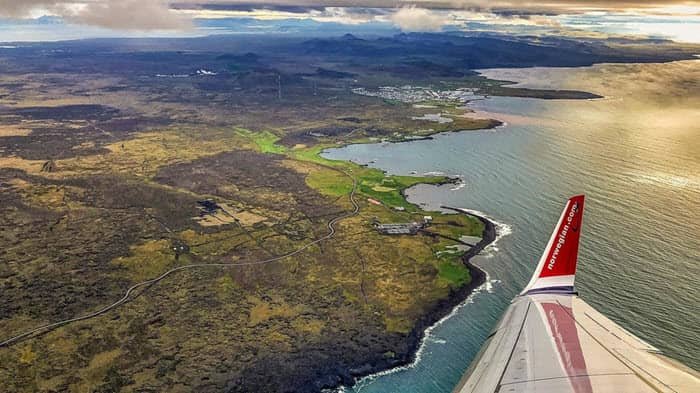- Foreign citizens travelling to Iceland from countries outside than the Schengen Zone will soon be needed to produce fingerprints and a photograph for facial recognition.
- To improve border control in Iceland, biometric data requirements will be implemented in 2021.

22-11-2022
Iceland is prepared to implement new technology at its borders. IDEMIA will operate a complete entry/exit system at air and sea border crossing sites by 2021, with the goal of increasing security.
The new entry/exit system will control travellers arriving in Iceland from outside the Schengen Area using biometric data. The primary goal is to identify visitors who have overstayed their guest permit or visa for Iceland.
The following is a summary of the new system’s benefits provided by Isavia, Iceland’s national airport and air navigation service provider:
“All airports with traffic crossing external borders will be affected by the Entry Exit system. With the help of the border police, Isavia is convinced that deploying IDEMIA’s self-service solutions will create a more safe and effective border crossing point, providing Keflavik the opportunity to expand even further as a hub operation.”
Continue reading to learn more about the new technology and how it will impact international travel to Iceland.
ICELAND IS PREPARED FOR SCHENGEN-WIDE BORDER REGULATION
Updated EU-EES laws will go into effect in 2022. Although Iceland is not a member of the EU, it is a member of the Schengen Area and will thus be subject to the new regulations.
These new rules require biometric data to be collected at the common travel zone’s external borders. All travellers arriving from countries outside the Schengen Zone must be checked.
Iceland has taken the first step. The nation will be well prepared for the anticipated changes in European visa policy if border control technology is implemented this year.
INCREASING SECURITY WITH BORDER CHECKS AND ETIAS
The border management system will be used in conjunction with the European Travel Information and Authorisation System beginning in November 2023. When it is launched, ETIAS, a visa waiver for visa-exempt non-EU visitors, will become a mandatory entry requirement.
ETIAS for Iceland will prevent potentially dangerous individuals from entering the country legally by screening them before they arrive in Europe.
The ETIAS system, combined with improved border management technology, will significantly improve security, making Iceland a safer travel destination.
HOW ICELAND’S NEW ENTRY/EXIT SYSTEM WILL WORK
Passport holders from non-Schengen countries will have their fingerprints and photographs taken upon arrival in Iceland. This information is then entered into an EU database and securely kept. Before leaving, another photograph is taken and compared to the image currently in the database.
Artificial intelligence at border control will allow authorities to identify anyone who has stayed in the Schengen Area for a period of time that exceeds the limit. The new ETIAS visa waiver will have the same maximum stay as Schengen visa holders, which is 90 days per 180-day period.
Although improving border management is the primary goal, collecting biometric data in this manner will have other applications, according to Jón Pétur Jónsson, Chief of Police for the National Police border division.
According to Jónsson, the police might utilise the technology to detect those who are not carrying identification. It is possible to snap a picture of the person and contrast it with pictures stored in the common EU database.
INNOVATIVE TECHNOLOGY AND BORDER MANAGEMENT SOLUTIONS
DEMIA was chosen for its competence in biometrics and border control, which, when combined with cutting-edge technology, would result in more secure external borders and more efficient passenger flow.
Philippe Barreau, IDEMIA’s Executive Vice President for Public Security and Identity, stated
“IDEMIA is happy to stand beside Iceland as one of the first Schengen Area countries to change its border control system to conform with the European Entry/Exit System. We are committed to providing a comprehensive set of multi-biometric solutions that will ensure a future-proof programme, making Iceland our innovative partner in the EU-EES implementation “.
IDEMIA equipment will soon be visible to passengers at Icelandic border control:
- TravelKioskTM EU-EES
- Multi-biometric border self-service kiosks
- Automated TraveLaneTM eGates
According to Barreau, this technology will simultaneously boost security and speed up and improve the passenger experience at border crossings.
Those worried about privacy should rest easy knowing that the system would be held to very tight data protection guidelines, according to Jón Pétur. The EU is adamant about following the rules when processing personal data, and all new procedures will do the same.
Managing a rise of Icelandic tourists
Over the past few years, Iceland has grown in popularity among tourists from outside the EU. Many of these visitors benefit from the EU’s visa-exemption policy, which allows citizens of more than 60 third countries to enter the Schengen Area for up to 90 days without a visa.
While greater tourism is beneficial for the economy, it has raised security worries throughout the shared transit zone.
ETIAS for Iceland and the entry/exit system are two systems established in response to rising visitor numbers and the need for greater control over who crosses borders and how long they stay.
Icelandic border security will improve with the upcoming implementation of the new entry/exit system and will be boosted further when ETIAS is implemented.
